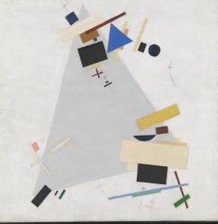Kazimir Malevich (1879- 1935) needs no formal introduction. We know him best for playing a key role in the invention of Russian Suprematism, which was a visual sort of language that represents itself in abstract colours and a variety of bizarre geometric shapes. His most famous work is of course, Black Square, which has also quickly become one of the leitmotifs of the modern art period. Given the period to which Malevich would live and work in, the age of Tsarist Russian, it is not surprising that he was able to fill his piece with conceptual ideals and thus denote bring meaning to Art.
The exhibition at the Tate brings together an International collection of his work from Europe, Russia and America. It is surprisingly the first retrospective to be staged on his work alone in thirty years, and the first time such a retrospective takes place in the UK. It is clear that Malevich deserves this status, despite the somewhat amateur style of his early artistic career that included paintings of Russian landscapes and religious scenes.
This was to be merely a blip in his career, and one that would eventually lead him to abstraction, before returning to figurative painting towards later life. The beauty of the exhibition can be seen in the way it tells spectators a story. This story is not simply about revolutionary practice, but it is one that also warns us of the potentials art possesses for total power and control. The exhibition brings together a vast collection of painting, drawings, theatre and sculpture, and highlights the number of artistic routes Malevich would take during his life, some more naïve, and others fully progressive.
The curation of the Malevich pieces was simply stunning. It provided a visual aid that enhanced the story of the exhibition. The exhibition is both chronological and thematic and this works to tell the artists compelling history in three precise stages. The first is Malevich’s working years prior to Black Square, the second focuses on abstraction, and the final attempts reconciliation between Suprematism and Figuration. It is as if in his final years, he was trying to search for a balance that linked the two most important phases of his artistic life together.
The second phase that focuses on abstraction is a clear winner, despite slight curatorial criticisms in terms of Black Square. Whilst displaying Black Square in solitude in a dark room, was a tactical move since it allows it to stand as a spotlight and beacon, the mood is slightly ruined by a video of Victory over the Sun that is playing (blasting) in the same room. Whilst this opera was an important influence on Black Square, the general feeling appears to be one that promotes silence in order for concentration and reflection. Given that it is his most important and iconoclastic gesture, you would have thought that more care and thought would go into the final touches of its display.
‘Iconic and ‘Master’ are words that seem to be thrown around quite a lot in terms of Modern Art. This exhibition however secures Malevich’s iconic status as an artist who was almost singlehandedly able to herald the start of a new culture. This culture would disrupt the old order through denoting a new way of seeing things, and would thus act as a point of reference and fascination for a generation of artists that still continues to exist today. It is as powerful as it is emotional, and requires spectators to look deeper to find the inner meaning and messages behind his pieces. The exhibition is priced at £14.50 (with 50% off for those with an Art Funds pass) and runs till the 26th October.

























 M
M

























































